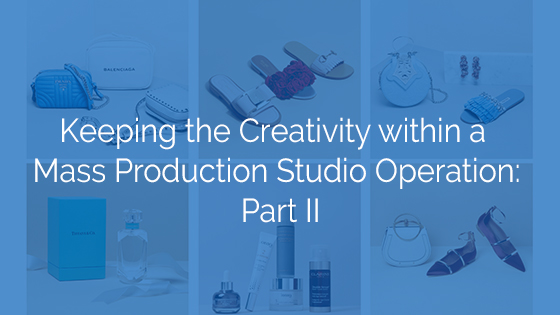In our last article about mass production, I discussed how absorbing smaller creative work from within the business (as it pertains to images and copy) can help with keeping your creative team members happy. In this article I’ll be covering the second major initiative which is:
Initiative: Allow your team to use studio equipment and facilities after hours and/or on off days.
The second initiative applies mostly to photographers and stylists, and if you’re a manager, this should be relatively easy to implement. This is the policy of allowing (and trusting) your team to use the studio equipment and facilities after hours and during off days.
This is a great way to encourage creativity, help your team stay relevant with the latest trends and techniques, and can do some experimenting that they wouldn’t necessarily get otherwise. From my experience, even the people that are shooting 100+ products day in and day out are artists at heart. It’s just unfortunate that a lot of times the process and policy demand that the team operates at such a speed within a restrictive style guide that they’re rarely able to truly express their art.
It’s like asking Dr. Dre to come work in a world-class studio with lots of great equipment but demanding he only produces variations of “Mary Had a Little Lamb”. He might be able to come in and produce a jam or two, but sooner or later it’s going to get stale.
It’s necessary to keep track of who and when the equipment and facilities are being used after hours, typically I have these requests and approvals go through email. It’s the simplest way to give a yes/no and have a record of who and when. Let’s explore why a studio or company might not permit this, and how to respond. These are some of the most common questions and concerns that I’ve come across and my answers:
Q: What if equipment gets broken during the shoot?
A: What would you do if equipment gets broken during the regular work hours? You’d have to replace or repair it. If the equipment has insurance or are covered under warranties and you’re using the equipment in “normal” circumstances, you should be covered. If you don’t have insurance, this might be something to consider.
Q: It’s additional wear and tear on the equipment
A: Most electronics depreciate on your P&L across a span of 3 years (US). And the purchases are considered a Capital Expenditure which means, if you want to get technical you can limit the impact and risk to your budget by only allowing the older, fully depreciated equipment to be used. To add to this, all equipment is going to either be obsolete at some point or wear out.
In my opinion, it’s better to wear the equipment out because you’re using it so much to push the boundaries and produce great work than to coddle the equipment to a point where it’s no longer technically relevant. Congratulations you’ve managed to use that D30 for the last 19 years!
Q: There will be no one from security to watch the area
A: This one can be a bit tricky, however where there’s a will there’s often a way. How does your current team handle OT days or working on a weekend during peak periods? If it’s a matter of having to pay extra security, then maybe there’s no workaround, however, unless there’s some larger company policy in place that prevents someone on the premise after hours, you should trust your team to be responsible enough to come in and shoot.
Q: What if something gets stolen?
A: This question is typically the real reason behind needing security in the first place. To me, if you can’t trust your team members to not steal equipment, then you have a much larger issue at hand. The way I always approach this situation is simple, “You have my trust until you give me a reason to believe otherwise”. Keeping a record of who’s in and when will help to troubleshoot if something does end up missing or hopefully just misplaced.
The Rewards Outweigh the Risks
By allowing your team to have the liberty to continue to learn, grow, create you’re ultimately helping your department. Your team will be happier, and less resentful towards the laborious day-to-day if they know that they’ll have at least have the opportunity and freedom to continue building their skills and portfolio. Who knows, maybe some of the work and experimentation that they come across can transcend back in to process and aesthetic improvements into the actual day-to-day. In the end, the potential rewards are much higher than the downside when considering the risks.

